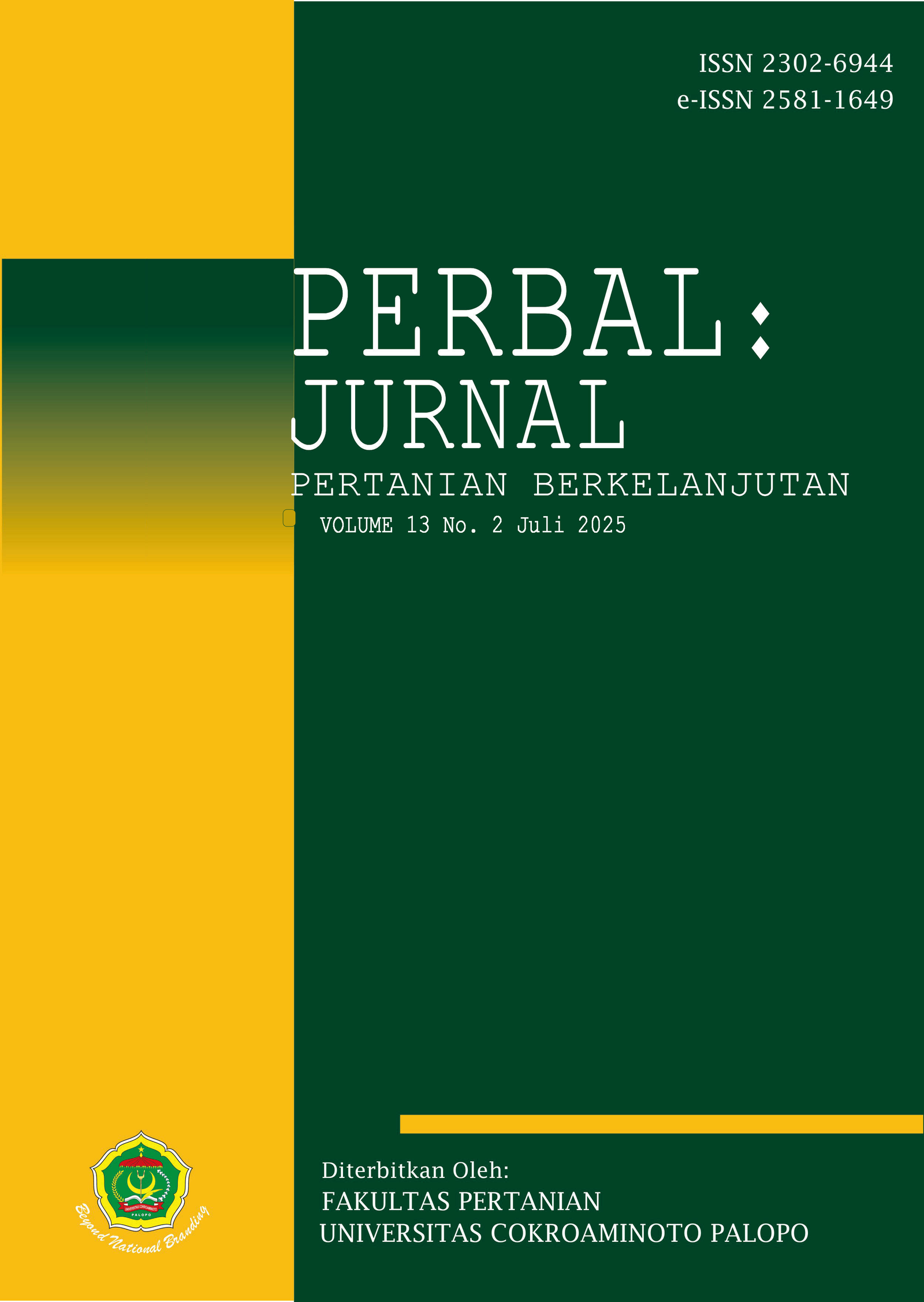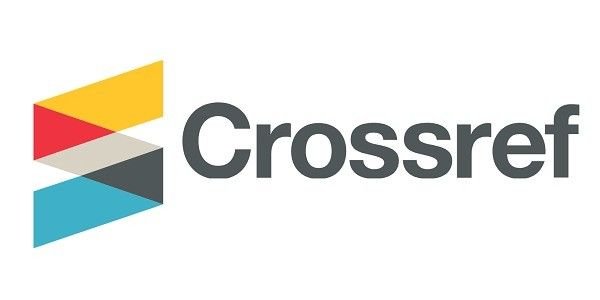Eksplorasi Cendawan Rhizosfer Tanaman Kakao Klon Lokal Kota Polewali Sulawesi Barat
Rhizosferic Fungal Exploration of Local Clone Cocoa (Theobroma cacao L.) from Polewali West Sulawesi
DOI:
https://doi.org/10.30605/perbal.v13i2.6402Keywords:
Cendawan rhizosfer, eksplorasi, kakao, klon lokal, Sulawesi BaratAbstract
Mikroorganisme tanah, khususnya yang berasal dari daerah rhizosfer, merupakan salah satu komponen penting dalam ekosistem pertanian yang berperan sebagai pemacu pertumbuhan tanaman secara alami. Penelitian ini bertujuan untuk mengeksplorasi dan mengevaluasi potensi cendawan rhizosfer dari tanaman kakao klon lokal asal Kota Polewali, Kabupaten Polewali Mandar, Sulawesi Barat sebagai pemacu pertumbuhan tanaman. Sebanyak 13 isolat cendawan berhasil diisolasi dari tanah rhizosfer tanaman kakao sehat. Selanjutnya, dilakukan uji patogenisitas terhadap daun kakao untuk mengetahui potensi patogenik isolat. Hasil menunjukkan bahwa 2 dari 13 isolat berpotensi patogenik dan tidak digunakan pada pengujian lanjutan. Sebanyak 11 isolat non-patogenik diuji lebih lanjut untuk mengetahui potensinya dalam merangsang pertumbuhan tanaman uji (jagung varietas rentan), baik dengan maupun tanpa perlakuan fungisida. Pengujian ini menghasilkan data bahwa 4 isolat memiliki potensi tinggi, yaitu dua isolat (EG dan EX) mampu merangsang pertumbuhan tanaman hingga 90%, sedangkan dua isolat lainnya (EF dan EW) hingga 80%. Temuan ini menunjukkan bahwa isolat-isolat tersebut berpotensi untuk dikembangkan sebagai pemacu pertumbuhan tanaman. Pendekatan ini sejalan dengan prinsip pertanian berkelanjutan karena mampu memperbaiki ekosistem tanah, meningkatkan efisiensi pemupukan, dan memperkuat ketahanan fisiologis tanaman terhadap stres lingkungan.
Soil microorganisms, particularly those originating from the rhizosphere, are among the most important components of agricultural ecosystems due to their natural role in promoting plant growth. This study aimed to explore and evaluate the potential of rhizospheric fungi isolated from local-clone cocoa plants in Polewali City, Polewali Mandar Regency, West Sulawesi, as plant growth promoters. This study aimed to explore and evaluate the potential of rhizospheric fungi from local cocoa clones originating from Polewali City, Polewali Mandar Regency, West Sulawesi, as biological control agents and plant growth-promoting fungi. A total of 13 fungal isolates were successfully obtained from the rhizosphere of healthy cocoa plants. Pathogenicity tests on cocoa leaves revealed that 2 out of 13 isolates exhibited pathogenic characteristics potentially and were excluded from further analysis. The remaining 11 non-pathogenic isolates were subsequently tested for their growth-promoting effects on a susceptible maize variety, both with and without fungicide treatment. The results demonstrated that four isolates showed promising potential: two isolates (EG and EX) stimulated plant growth up to 90%, while two others (EF and EW) stimulated up to 80%. These findings indicate that the selected isolates have promising potential for development as plant growth-promoting agents. This approach aligns with the principles of sustainable agriculture, as it contributes to improving soil ecosystems, enhancing nutrient use efficiency, and strengthening the physiological resilience of plants to environmental stress.
Downloads
References
Akter, M.S., Siddique, S.S., Momotaz, R., Arifunnahar, M., Alam, K.M., & Mohiuddin, S.J. (2019). Biological control of insect pests of agriculture crops through habitat management was discussed. Journal of Agriculture Chemistry and Environment, 8(1), 1–13. DOI: https://doi.org/10.4236/jacen.2019.81001
Asman, A., Rosmana, A., Bailey, B.A., Ali, S.S., Iwanami, T., Sjam, S., Amin, N., & Kuswinanti, T. (2024). Pathogenicity of Lasiodiplodia theobromae isolated from cocoa dieback disease in South Sulawesi, Indonesia. Journal of Phytopathology, 172(4). DOI: https://doi.org/10.1111/jph.13352. DOI: https://doi.org/10.1111/jph.13352
Ayaz, M., Li, C.H., Ali, Q., Zhao, W., Chi, Y.K., Shafiq, M., Ali, F., Yu, X.Y., Yu, Q., Zhao, J.T., Yu, J.W., Qi, R.D., & Huang, W.K. (2023). Bacterial and fungal biocontrol agents for plant disease protection: journey from lab to field, current status, challenges, and global perspectives. Molecules, 28(18), 6735. doi: 10.3390/molecules28186735. PMID: 37764510; PMCID: PMC10537577. DOI: https://doi.org/10.3390/molecules28186735
Azis, A.I., Rosmana, A., & Dewi, V.S. (2013). Pengendalian penyakit hawar daun phytophthora pada bibit kakao dengan Trichoderma asperellum. Jurnal Fitopatologi Indonesia, 9(1), 15–20. DOI: https://doi.org/10.14692/jfi.9.1.15
Barnett, H.L. & Hunter, B. (1998). Ilustrated genera Of Imperfect Fungi. The American Phyropathological SocietySt. Paul. Columbia.
BPS (Badan Pusat Statistik) Indonesia. (2024). Statistik Kakao Indonesia 2023. 23(1), 25-32. Volume 8. ISSN 2714 –8440.
Dugan, F.M. (2017). The Identification of Fungi: An Illustrated Introduction with Keys, Glossary, and Guide to Literature. St. Paul: APS Press; https://doi.org/10.1094/9780890545041. DOI: https://doi.org/10.1094/9780890545041
Fitriadi, B.R. & Putri, A.C. (2019). Dampak apliukais pestisida sipermetrin, deltametrin, klorpirifos dan λ-sihalotrin terhadap kandungan residu pestisida pada biji kakao. Jurnal Agrosains dan Teknologi, 4(1), 10 –18. DOI: https://doi.org/10.24853/jat.4.1.10-18
Mahmood, I., Imadi, S.R., Shazadi, K., Gul, A., & Hakeem, K.R. (2016). Effects of pesticides on environment. In: Hakeem, K.R., & Shazadi, K. editors. Plant, Soil, and Microbes, 1. Implications in Crop Science. Switzerland: Springer, 253 – 266. DOI: https://doi.org/10.1007/978-3-319-27455-3_13
Mirsam, H., Suriani, Aqil, M., Azrai, M., Efendi, R., Muliadi, A., Sembiring, H., & Azis, A.I. (2022). Molecular characterization of indigenous microbe and its potential as a biological control agent of fusarium stem rot ( Fusarium Verticillioides) on maize. Heliyon, https://papers.ssrn.com/sol3/papers.cfm?abstract_id=4046741 DOI: https://doi.org/10.2139/ssrn.4046741
Naik, K., Mishra, S., Srichandan, H., Singh, P.K., & Sarangi, P.K. (2019). Plant growth promoting microbes: Potential link to sustainable agriculture and environment. Biocatalysis and Agricultural Biotechnology, 21 (101326). DOI: https://doi.org/10.1016/j.bcab.2019.101326. DOI: https://doi.org/10.1016/j.bcab.2019.101326
Pathan, S.I., Ceccherini, M.T., Sunseri, F., & Lupini, A. (2020). Rhizosphere as Hotspot for Plant-Soil-Microbe Interaction. Carbon and Nitrogen Cycling in Soil. Springer, Singapore, pp. 17– 43. DOI: https://doi.org/10.1007/978-981-13-7264-3_2
Poudel, S., Poudel, B., Acharya, B., & Poudel, P. (2020). Pesticide use and its impact on human health and environment. Environment & Ecosystem Science, 4(1), 47 – 51. DOI: https://doi.org/10.26480/ees.01.2020.47.51
Ratnawati, R., Arfan, A., Jaya, K., & Annisa, A. (2024). Potential of cocoa derived-endophytic fungi in the biocontrol of Phytophthora palmivora. International Journal of Design & Nature and Ecodynamics, 19(6), 2179–2185. https://doi.org/10.18280/ijdne.190634. DOI: https://doi.org/10.18280/ijdne.190634
Rosmana, A., Nasaruddin, N., Hendarto, H., Hakkar, A.A., & Agriansyah, N. (2016). Endophytic association of Trichoderma asperellum within Theobroma cacao suppresses vascular streak dieback incidence and promotes side graft growth. Mycobiology, 44(3), 180–186. DOI: 10.5941/MYCO.2016.44.3.180. DOI: https://doi.org/10.5941/MYCO.2016.44.3.180
Sudantna, I.M., Sudirman, & Ernawati, N.M.L. (2021). The effect of method and dosage application of biofungicide extract of legundi leaf fermentation with Trichoderma harzianum fungus for control Fusarium wilt disease on shallots. IOP Conf. Series: Earth and Environmental Science, 913. DOI: 10.1088/1755-1315/913/1/012014. DOI: https://doi.org/10.1088/1755-1315/913/1/012014
Vijai, K.G., Schmoll, M., Herrera-Estrella, A., Upadhayay, R.S., Druzhinina, I., & Tuohy, M.G. (2014). Biotechnology and Biology of Trichoderma . ISBN: 978-0-4444-59576-8. Elsevier.
Downloads
Published
Issue
Section
License
Copyright (c) 2025 Asti Irawanti Azis, Vien Sartika Dewi, Erna Erna, Ade Rosmana

This work is licensed under a Creative Commons Attribution 4.0 International License.
In submitting the manuscript to the journal, the authors certify that:
- They are authorized by their co-authors to enter into these arrangements.
- The work described has not been formally published before, except in the form of an abstract or as part of a published lecture, review, thesis, or overlay journal.
- That it is not under consideration for publication elsewhere,
- That its publication has been approved by all the author(s) and by the responsible authorities – tacitly or explicitly – of the institutes where the work has been carried out.
- They secure the right to reproduce any material that has already been published or copyrighted elsewhere.
- They agree to the following license and copyright agreement.
License and Copyright Agreement
Authors who publish with Onoma Journal: Education, Languages??, and Literature agree to the following terms:
- Authors retain copyright and grant the journal right of first publication with the work simultaneously licensed under Creative Commons Attribution License (CC BY 4.0) that allows others to share the work with an acknowledgment of the work's authorship and initial publication in this journal.
- Authors are able to enter into separate, additional contractual arrangements for the non-exclusive distribution of the journal's published version of the work (e.g., post it to an institutional repository or publish it in a book), with an acknowledgment of its initial publication in this journal.
- Authors are permitted and encouraged to post their work online (e.g., in institutional repositories or on their website) prior to and during the submission process, as it can lead to productive exchanges, as well as earlier and greater citation of published work.














